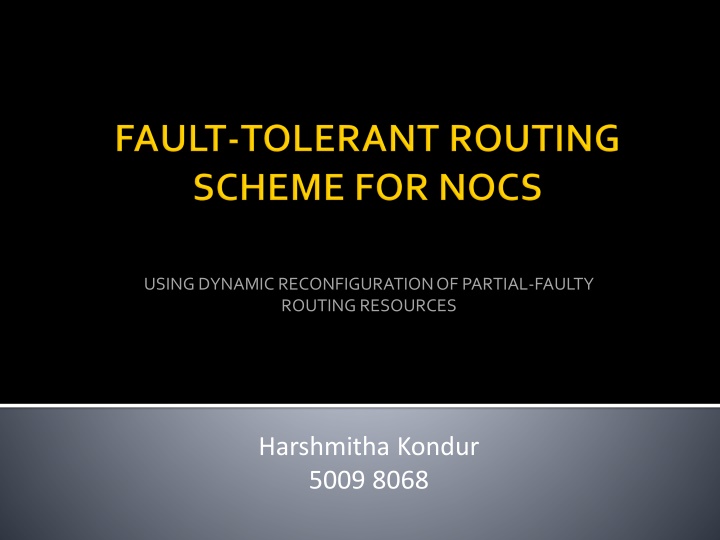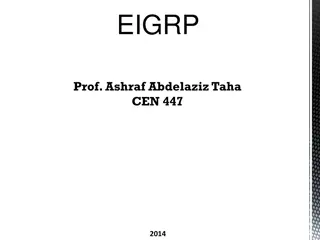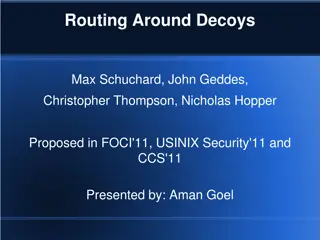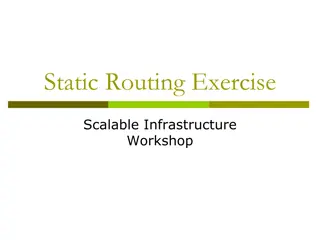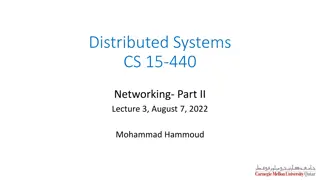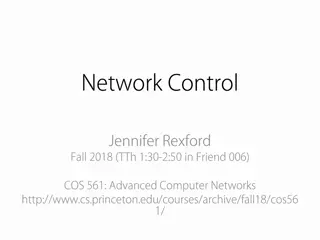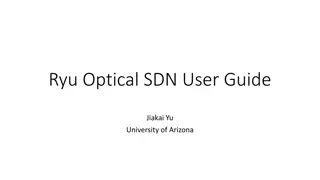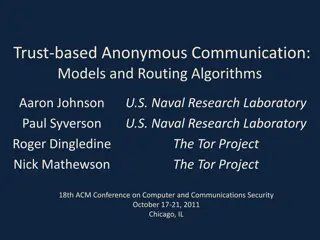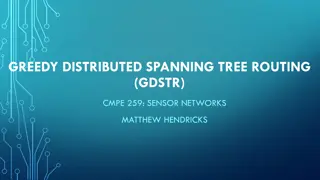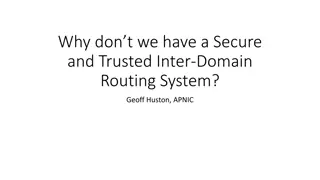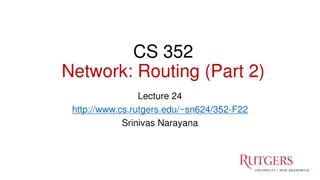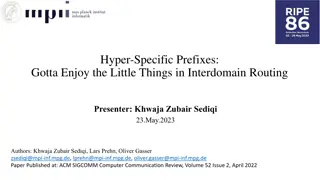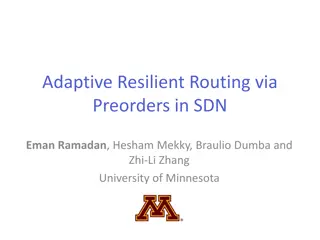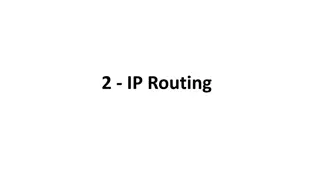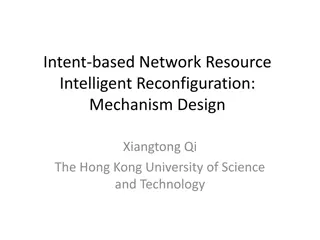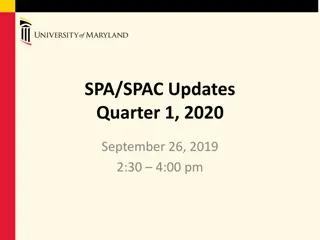Dynamic Reconfiguration of Faulty Routing Resources
Network on Chip (NoC) is a communication subsystem on an integrated circuit enabling multi-hop, packet-switched communication. NoCs borrow ideas from computer networks, using packets to route data between cores. Routers handle communication and routing, with control and data path modules. Explore dynamic reconfiguration of partial-faulty routing resources in NoC designs for fault detection, recovery, and deadlock prevention.
Download Presentation

Please find below an Image/Link to download the presentation.
The content on the website is provided AS IS for your information and personal use only. It may not be sold, licensed, or shared on other websites without obtaining consent from the author.If you encounter any issues during the download, it is possible that the publisher has removed the file from their server.
You are allowed to download the files provided on this website for personal or commercial use, subject to the condition that they are used lawfully. All files are the property of their respective owners.
The content on the website is provided AS IS for your information and personal use only. It may not be sold, licensed, or shared on other websites without obtaining consent from the author.
E N D
Presentation Transcript
USING DYNAMIC RECONFIGURATION OF PARTIAL-FAULTY ROUTING RESOURCES Harshmitha Kondur 5009 8068
Network on Chip Detection of Faults Router Dynamic Buffer Swapping Topology & Properties Dynamic Mux Swapping Faults Deadlock Recovery NoC Faults Simulation and Results Router Faults Summary Fault Recovery Systems Significance Existing System Proposed System
Network on chip (NoC) is a communication subsystem on anintegrated circuit Communication occurs between coresin a system on a chip. Implements multi-hop and predominantly packet-switched communication.
NoCs borrow ideas and concepts from Computer Networks & apply them to the embedded SoC domain. NoCs use packets to route data from the source PE to the destination PE via a network fabric that consists of Network interfaces/adapters (NI) Routers (a.k.a. switches) Interconnection links (channels, wires bundles) Multiple routes from the host to clients. Each node directly connects to a limited number of neighboring nodes.
Network on Chip Detection of Faults Router Dynamic Buffer Swapping Topology & Properties Dynamic Mux Swapping Faults Deadlock Recovery NoC Faults Simulation and Results Router Faults Summary Fault Recovery Systems Significance Existing System Proposed System
Routers handle communication and directly connects to neighboring nodes routers. Routing is the route/path (a sequence of channels) of streets from source to destination The router consists of 2 major modules: Control Path Data Path
Contol Path: 1) Routing Computation (RC) 2) Switch Allocation (SA) 3) Virtual Channel Allocation(VA) Data Path: Buffers Switching Cross-bars Output Registers 1) 2) 3)
5 ports, wormhole, 5cycle pipeline 39-bit (32data , 6ctrl, 1str) bidirectional mesochronous P2P links per port 2 logical lanes each with 16 flit-buffers Performance, area, power Freq 5.1GHz @ 1.2V 102GB/s raw bandwidth Area 0.34mm2 (65nm) Power 945mW (1.2V), 470mW (1V), 98mW (0.75V) Fine-grained clock-gating + sleep (10 regions)
Network on Chip Detection of Faults Router Dynamic Buffer Swapping Topology & Properties Dynamic Mux Swapping Faults Deadlock Recovery NoC Faults Simulation and Results Router Faults Summary Fault Recovery Systems Significance Existing System Proposed System
Most popular topology All links have same length Eases physical design Area grows linearly with number of nodes Must be designed in such a way as to avoid traffic accumulating in the center of the mesh
High level ofparallelism Enhanced performance (such asthroughput) andscalability Efficient utilization of communication resources than traditional on-chip buses. Regular NoC structures reduce VLSI layout complexity compared to custom routed wires
Multi-hop and predominantly packet-switched communication Dynamic Adaptive Routing algorithm Flexible QoS guarantees Higher bandwidth Reusable components Buffers, arbiters, routers, protocol stack
Network on Chip Detection of Faults Router Dynamic Buffer Swapping Topology & Properties Dynamic Mux Swapping Faults Deadlock Recovery NoC Faults Simulation and Results Router Faults Summary Fault Recovery Systems Significance Existing System Proposed System
Faults in a NoC router are of 2 types: Transient Faults Permanent Faults Transient Faults: on-chip cross-talks and coupling noise Alpha particles emitted by trace uranium and thorium impurities in packages and high-energy neutrons from cosmic radiations can cause soft errors in semi-conductor devices. Similarly, low energy cosmic neutrons interacting with isotope boron-10 can cause soft errors.
Permanent Faults: worn-out devices, manufacturing defects and accelerated aging effects. Electro-migration of a conductor, broken wires, dielectric breakdowns etc. are a few examples of permanent failures on chip. Permanent faults, at one level, are modeled as stuck-at faults, or as fail-stop model where a complete module malfunctions and informs its neighbors about its out-of-order status.
Faults appear due to the following reasons: susceptibility of shrinking feature sizes to process variability age-related degradation crosstalk single-event upsets. Large numbers of faults will have to be tolerated to sustain chip production yield and reliable operation Rapid development in silicon technology is enabling the chips to accommodate billions of transistors .
Shrinking silicon die size : enhanced levels of cross talks, high field effects and critical leakage currents. Growing number of cores on a chip Electro-migration of a conductor Gaussian noise on a channel and alpha particles: strikes on memory and logic can cause one or more bits to be in error
We focus on dealing with the permanent NoC faults since it has a more significant impact on the system performance. The permanent faults are divided into two: Static fault : Faults occurred at the interconnect wires Dynamic fault : Recovery of the router faults, cross bar and buffer faults. Since the major portion of the router constitutes of the cross-bar and the buffer, the majority of the faults occur there.
Network on Chip Detection of Faults Router Dynamic Buffer Swapping Topology & Properties Dynamic Mux Swapping Faults Deadlock Recovery NoC Faults Simulation and Results Router Faults Summary Fault Recovery Systems Significance Existing System Proposed System
1) The faulty router is treated as a node fault and the routing algorithm can be dynamically reconfigured to re-route the packets following the contour around the faulty nodes. Reference: Zhen Zhang, A. Greiner, and S. Taktak, A reconfigurable routing algorithm for a fault-tolerant 2d-mesh network-on-chip," in Proc DAC, 2008, pp. 441 {446. Disadvantages: This region-based routing algorithm is only suitable for one-faulty-router topology. Also, the node fault model may cause the faulty router totally isolated from the network, while in real situation, the faults may only affect a certain part of the router and the rest of it can still function correctly.
2) After the built-in-self-test procedure and a static port swapping, the remaining faults (both link faults and unswapped buffer/MUX faults) are all treated as link level hard failures Reference:D. Fick, A. DeOrio, Jin Hu, V. Bertacco, D. Blaauw, and D. Sylvester, Vicis: A reliable network for unreliable silicon, in Proc DAC,2009,pp.812- 817. D. Fick, A. DeOrio, G. Chen, V. Bertacco, D. Sylvester, and D. Blaauw, A highly resilient routing algorithm for fault-tolerant nocs," in Proc DATE, 2009, pp. 21 - 26. A resilient routing algorithm is designed to reconfigure the routing table in an offline process so as to bypass these fault links. Both the port swapping operation and routing table reconfiguration in are static in nature
3) A deflection routing algorithm is proposed to dynamically re- route the packets towards the destinations. Reference: A. Hosseini, T. Ragheb, and Y. Massoud, A fault-aware dynamic routing algorithm for on-chip networks," in Proc ISCAS, 2008, pp. 2653 - 2656. The NoC faults are treated as the link faults also and it needs to avoid deadlock and livelock based on the stress factors.
A faulty router with an appropriate reconfiguration strategy tolerates the buffer or crossbar errors Supports the full connectivity in the NoC with reduced capacity Previously suggested fault tolerant models result in the network being partitioned. Hence the dynamic swapping scheme is suggested which shares the healthy resources in the router for different ports at run time.
Dynamic reconfiguration (DR) enables resources to be added or removed while the operating system (OS) is running DBS and DMS operation will dynamically share the healthy resources among different ports in run time and hence improve the performance. A deflection routing algorithm is proposed to dynamically re-route the packets towards the destinations. Leveraging the other healthy buffers or multiplexers (Muxes) and dynamically re-allocating the resources These dynamically reconfigure the routers to handle buffer faults and crossbar faults while still maintaining the maximum service of the router.
Network on Chip Detection of Faults Router Dynamic Buffer Swapping Topology & Properties Dynamic Mux Swapping Faults Deadlock Recovery NoC Faults Simulation and Results Router Faults Summary Fault Recovery Systems Significance Existing System Proposed System
Faults In routers can be detected with built-in-self-test (BIST) and self-diagnose circuits. A hybrid fine-grained fault model distinguishes the nature and consequence of faults Suggests fault-diagnosis technique to determine the type of fault.
Fault Diagnosis Structure: To determine the occurrence, type and position of the faults. Module in this system are: Cyclic Redundancy check: Switch Switch error Intra router error BIST controller: sends test patterns to the other router. TPG 1: TP for buffers TPG2: TP for cross bar
These errors are forwarded to the DBS and DMS modules for router reconfiguration
Network on Chip Detection of Faults Router Dynamic Buffer Topology & Properties Swapping Faults Dynamic Mux Swapping NoC Faults Deadlock Recovery Router Faults Simulation and Results Fault Recovery Systems Summary Existing System Proposed System Significance
Dynamic buffer swapping (DBS) algorithm is proposed to handle the input buffer faults. Proper swapping of another substitute buffer to hold the packets destined for the faulty buffer Graceful performance degradation can be achieved by fully utilizing the link No extra buffers or virtual channels are needed in the router, which satisfies the stringent area constraint of NoC.
DBS Operation: State S0 Assume fault occurs at the north input buffer of router R1 packet 0 is blocked in router R2 State S1 R1 will arrange east port buffer to substitute the north buffer. Traffic control token is sent to router R4 indicating that the transmission link (R1- R4) will be shut down in the next state for DBS operation State S2 communication between R2-R1 link is enabled packet 0 can thus be transmitted to R1 s east input buffer and further be forwarded towards its destinations. State S0 is regained.
Avoid Packet interleaving: Interference of packets from 2 routers Two handshake signals, current transmit status (CTS) and current port status (CPS) for each port. The router can send the packets across the link only when it receives a 1 in the CTS
Network on Chip Detection of Faults Router Dynamic Buffer Swapping Topology & Properties Dynamic Mux Swapping Faults Deadlock Recovery NoC Faults Simulation and Results Router Faults Summary Fault Recovery Systems Significance Existing System Proposed System
Dynamic MUX swapping (DMS) technique is used to mitigate the MUX faults and make all the output links available for routing. The crossbar in the router is usually implemented in the form of five 4 1 MUXs If one of the MUX malfunctions, the data will not be presented to the output link correctly. Ring-based crossbar swapper is proposed The ring topology allows each MUX to be shared among its neighboring output ports. All output links can be maintained.
If the MUX corresponding to the east output port is faulty, the MUX for the north port can be time shared with the north and east ports by turning on-off the switches in MUX swapper accordingly. By doing so, all the output links can be maintained.
Network on Chip Detection of Faults Router Dynamic Buffer Swapping Topology & Properties Dynamic Mux Swapping Faults Deadlock Recovery NoC Faults Simulation and Results Router Faults Summary Fault Recovery Systems Significance Existing System Proposed System
Routers working in the DBS mode may face potential deadlocks. When faults occur, due to the DBS or the re-routing, a deadlock may be introduced. To ensure deadlock free routing, in normal operation, Odd-even (OE) routing algorithm is used in our framework. Circular dependency on the NoC resources may bring deadlocks and stall the whole system. For DMS operation, we only time-share the MUX between two output ports and do not change the dependency of the buffers in the routing algorithm. No deadlocks.
Local deadlock: Occurs between the two nodes R1 andR2 The south port of R2 and north port of R1 are faulty If all the packets in other ports choose these two ports as output R1 (R2) will be stuck at state S1 waiting for the original packets in the substitute port of R2 (R1) being completely transmitted. Global deadlock: Assume the south to east turn is forbidden. Scheduler in R2 arranges its west input buffer to hold packets from north Scheduler in R1 arranges its east input buffer to substitute the faulty south buffer a circular dependency on buffer resources can thus be generated
When the router receives the header flit of a packet, an embedded counter is triggered to count the number of cycles it stays in the buffer. The counter continues to increment until the tail flit has been successfully transmitted or its value exceeds a predefined threshold Tsh. In the latter case, the router will enter the deadlock handling mode. After that the counter would be reset and waits for next packet.
The east input buffer of R2 to swap with the north faulty buffer, we can break the original dependency and avoid the blockage. If all the ports in the router are not available for swapping we will reset the routing computation (RC), switch allocation (SA) information of these packets to request a different output port. if packet 1 chooses the west instead of south as output direction and leaves R2 successfully, then the deadlock problem can be solved accordingly.
Another strategy is to use the leader election algorithm. Once the nodes in deadlock are detected, the arbiters decisions of each node are saved. The node s output channels are reused for selecting the leader among those nodes. After the leader node being elected, all nodes reconstruct its previous arbiter decision and wait for the incoming leader packets together with a preemption indicator. This preemption indicator sent by the elected leader node will make the entire message bypass the deadlocked nodes up to its destination. When a buffer becomes available after this process, all the other nodes will leave their awaiting state to transmit its deadlocked messages. This is similar to the prioritization of messages in computer networks.
If the re-computation step fails to relieve the blockage, and the local processing element (PE) has available memory spaces in network interface (NI). Next, we will send these blocked packets to the local PE, and make the PE re- send these packets to the destination. In order to avoid creating a new circular dependency between the PE and other routers, this operation is carried out only when NI has free memory slots. If the memory in NI is full, we need to drop the current packet and require a higher level end-to-end re-transmission protocol to re-send the packets
Network on Chip Detection of Faults Router Dynamic Buffer Swapping Topology & Properties Dynamic Mux Swapping Faults Deadlock Recovery NoC Faults Simulation and Results Router Faults Summary Fault Recovery Systems Significance Existing System Proposed System
An NoC network was constructed using Noxim Simulator and systemC. No Faults Including DBS 60 90 80 50 70 40 60 Latency Latency 50 30 40 20 30 20 10 10 0 0 0.005 0.007 0.009 0.013 0.015 0.0215 0.023 0.025 0.005 0.007 0.009 0.013 0.015 0.0215 0.023 0.025 PIR PIR
Simulation for DBS with deadlocks. Comparison of networks under fault and deadlocks.
Network on Chip Detection of Faults Router Dynamic Buffer Swapping Topology & Properties Dynamic Mux Swapping Faults Deadlock Recovery NoC Faults Simulation and Results Router Faults Summary Fault Recovery Systems Significance Existing System Proposed System
Proposed a fault-tolerant framework for Network on Chips (NoC) to achieve maximum performance under fault. Distinguish the faulty components and handle them according to their fault classes. Two new dynamic reconfiguration schemes at the router level, namely Dynamic Buffer Swapping (DBS) and Dynamic MUX Swapping(DMS), are proposed to deal with the buffer and cross- bar faults accordingly, which are the main sources of failure in the router. Healthy resources in the router are maximally utilized to mitigate the faults A deadlock recovery scheme is designed to handle the potential deadlock hazard due to the proposed DBS operation
Network on Chip Detection of Faults Router Dynamic Buffer Swapping Topology & Properties Dynamic Mux Swapping Faults Deadlock Recovery NoC Faults Simulation and Results Router Faults Summary Fault Recovery Systems Significance Existing System Proposed System
